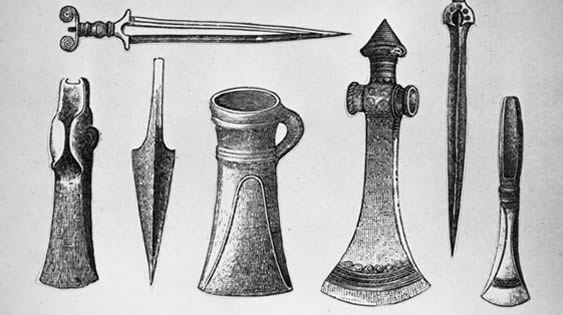Technology Development during the Iron Age

Iron Age is the archaeological period which occurs after the Stone Age and BronzeAge, which is famous for its use of iron for items of everyday life. Other than iron,steel was also used during the period. With the widespread use of iron, significantchanges in many areas such as agricultural activities, religious beliefs and style of artwere also noticeable. The definition of ‘Iron Age’ in archaeological terms is theperiod where people use iron as the main material for the cutting tools and weaponsas their civilization and their culture.
Even though the term ‘Iron Age’ is very general and is almost known by everyone,the chronological value of the term is actually quite low. This is because noteveryone started using iron at the same time. The periods vary from region toregion. There are also some areas that skipped the Bronze Age and directly evolvedto the Iron Age from the Stone Age. Such examples include the islands of the SouthPacific, the interior of Africa and some areas of North and South America.
During the Iron Age, the best weapons and the best tools were made from steel,which is a combination of iron and carbon. These alloys usually had a content of0.3% to 1.2% of carbon in them. The higher the carbon content, the harder the metalbecomes. Steel tools weighted almost the same as bronze tools used back in theBronze Age, but these steel tools proved much stronger. However, steel wasextremely complicated to produce with the methods available during that time, andlower quality alloys that were easier to make than steel such as wrought iron were acommon sight then.
History Among the Continents
Near East
In Chaldaea and Assyria, the use of iron reaches as far back as around 4000 BC. One of the earliest found items that was made of iron in that particular area was a dagger with an iron blade. In the Ancient Near East however, the Iron Age was believed to have begun with the discovery of techniques in Anatolia or the Caucasus in 1300 BC. The development of iron smelting was once linked to the Hittites of Anatolia. Several sources claimed they had a monopoly of ironworking and their empire improved based on that leverage.
Europe
In Europe, iron usage was known to cover from the late prehistory era to the early historic period. Ironworking was introduced to Europe in the late 11th Century BC. Use of iron in Europe was implemented simultaneously with Asia. As the knowledge of iron in Europe started from the southern regions and expanded northwards, the start of the Iron Age was very much earlier in the southern regions compared to the northern regions. The Iron Age in Europe can be characterized by an increment of decorations in the weapons and daily utensils. The decoration evolved from a simple rectilinear design to a sophisticated curvilinear design.
Asia
In Asia, the use of iron for daily usage was implemented the same time it got implemented in Europe. For China, uses of iron dates back to around 4000 years before the Common Era. In Central Asia, the Iron Age began when a number of iron objects appeared among the Indo-European Saka (in present-day Xinjiang) between the 10th Century BC and the 7th Century BC. In East Asia, countries such as China, Japan and Korea developed the use of iron mainly between the 10th Century BC and the 4th Century BC.
Africa
In Africa, there was no universal Bronze Age which can be generalized. The use of iron came straight after the use of stone, thereby skipping the use of bronze. Parts of Sub-Saharan Africa produced very little instances of carbon steel, 2000 years before present day in northwest Tanzania, based on their own complicated pre-heating techniques.
India
The earliest Iron Age sites in South India are namely Hallur, Karnataka and Adichanallur, Tamil Nadu. These parts were known for the iron during the 1000 BC period. Studies by archaeologists in Karnataka confirmed that the blacksmiths of that particular region could deal with several huge artifacts, implying that the blacksmiths have known the way of the iron centuries long before the real Iron Age began to occur.
